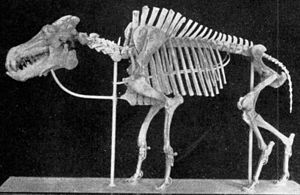Daeodon
| Daeodon | ||||||||||||
|---|---|---|---|---|---|---|---|---|---|---|---|---|

Skeleton of a Daeodon |
||||||||||||
| Temporal occurrence | ||||||||||||
| Oligocene to Miocene | ||||||||||||
| Locations | ||||||||||||
|
North America |
||||||||||||
| Systematics | ||||||||||||
|
||||||||||||
| Scientific name | ||||||||||||
| Daeodon | ||||||||||||
| Cope , 1879 | ||||||||||||
Daeodon , formerly known as Dinohyus (German: Terrible Pig), is an extinct mammal . It lived from the Oligocene to the early Miocene and was one of the Entelodontidae , an also extinct family of large hog-like ungulates .
External features
Daeodon was three meters long and reached a good two meters shoulder height. The head was extremely large, almost three feet long, but the brain was relatively small. He had quite long, slender limbs , which suggest that he could run fairly quickly and therefore probably actively hunted. It weighed a ton and had strong tusks. His shoulders were very muscular to keep his heavy head upright. As with a real predator , the eyes were forward-facing, so the field of view likely overlapped.
Way of life
Daeodon ate a variety of plants and animals including carrion . He probably hunted actively because of his body. However, he probably also fed on carrion. Its mouth had a bone-grinding power.
Locations
Fossil specimens of the genus have been found in North America . The first lower jaw bones found from the John Day Fossil Beds were described by Edward Drinker Cope as a Daeodon in 1879 . Later, the Carnegie Museum curator , OA Peterson , found a more complete copy in the Agate Fossil Beds in Nebraska . In 1905 he called it Dinohyus and gave it the species name hollandi , after the family name of the then director of the Carnegie Museum in Pittsburgh , William Jacob Holland .
swell
- David Lambert: Lexicon of dinosaurs and other prehistoric animals. Dorling Kindersley, Munich 2001, ISBN 3-8310-0342-4 , pp. 264-265.